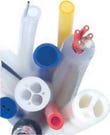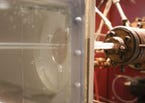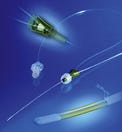Outsourcing Outlook: Extrusion Services
July 7, 2011
 Medical device OEMs are increasingly demanding complex extruded tubing with shrinking wall thicknesses and multiple lumens. Addressing these and other medical extrusion issues is Rudi Gall, managing director of Raumedic Inc. (Leesburg, VA).
Medical device OEMs are increasingly demanding complex extruded tubing with shrinking wall thicknesses and multiple lumens. Addressing these and other medical extrusion issues is Rudi Gall, managing director of Raumedic Inc. (Leesburg, VA).
MPMN: What key extrusion capabilities should the OEM require of an extruder?
Gall: Tubing used in such medical devices as catheters is growing more and more sophisticated as OEMs seek tubing products that deliver ever-increasing performance levels. This trend is especially associated with the growing prevalence of minimally invasive surgery. While today's extruded medical tubing must maintain the same microdiameter sizes as previous-generation tubes, it must also feature multiple lumens with guidewire access capability, fluid-transfer channels, and inflation ports. Lumens that provide steering functionality are also in demand. Contract manufacturers should demonstrate the ability to work with properly dimensioned drawings, producing tubing with up to 13 lumens, for example. To achieve improved device functionality, OEMs should also consider coextrusion capability. Coextrusions feature a kink-resistant polyamide inner layer and a polyurethane outer layer, on which length markers can be printed. While such coextruded catheters must have very small dimensions and be flexible enough to spare spinal cord nerves, they must also offer kink resistance to negotiate the tight radii between the spinal vertebrae.
Expanded Q&A with Rudi Gall: |
MPMN: What types of materials must an extruder be able to process?
Gall: The OEM should demand that a prospective partner have experience with medical-grade materials that meet biocompatibility, temperature, and durability requirements. For example, such invasive tubing as epidural catheters come into contact with blood, nerves, and bone. Vascular catheters, on the other hand, come into contact with blood and the inner walls of veins and arteries. In addition to thermoplastic polyurethanes, polyamides, polyolefins, and thermoplastic elastomers, manufacturers should be able to process PEI and PEEK.
MPMN: What new challenges are involved in fabricating extruded tubing?
Gall: While the trend toward miniaturization seems to be unstoppable and small dimensions can be achieved, the real challenge will be creating ever-thinner tubing walls with ever-tighter tolerances without causing tubing designs to collapse. Such miniature designs also raise repeatability and reproducibility issues. As tubing dimensions shrink, another challenge is the incorporation of electronics into medical devices, which demands that manufacturers be able to embed copper wires in tubing walls to enable data transfer. Finally, the need to guide catheters through tiny blood vessels places increasing demands on contract extruders to develop metal- or filament-reinforced tubing.
Silicone thin-wall extruded tubing Serving the medical device industry, MRPC extrudes various restricted and unrestricted silicones into thin-wall tubing with tight inner- and outside-diameter tolerances. The ISO 9001- and ISO 13485-certified manufacturer can produce multilumen tubing, microlumen tubing, thin-wall tubing, and components featuring complex shapes. It also performs a selection of secondary processing operations that includes laser machining, surface treatment, cutting to length, skiving, joining, and assembly. In addition, the company is able to embed wire or radiopaque materials into the extruded tubing.
Serving the medical device industry, MRPC extrudes various restricted and unrestricted silicones into thin-wall tubing with tight inner- and outside-diameter tolerances. The ISO 9001- and ISO 13485-certified manufacturer can produce multilumen tubing, microlumen tubing, thin-wall tubing, and components featuring complex shapes. It also performs a selection of secondary processing operations that includes laser machining, surface treatment, cutting to length, skiving, joining, and assembly. In addition, the company is able to embed wire or radiopaque materials into the extruded tubing.
MRPC
Butler, WI
www.mrpcorp.com
Thermoplastic single- and multilumen extrusions Offering thermoplastic extrusion services, VistaMed is equipped to deliver tight-tolerance tubing for medical device applications. The service provider works with a variety of materials--including PEEK, FEP, polycarbonate, nylon, and other thermoplastics--to produce single- and multilumen tubing, coextrusions, bump tubing, and wire-reinforced tubing. The company maintains two ISO 13485-certified and FDA-registered facilities with ISO Class 7- and ISO Class 8-certified cleanrooms.
Offering thermoplastic extrusion services, VistaMed is equipped to deliver tight-tolerance tubing for medical device applications. The service provider works with a variety of materials--including PEEK, FEP, polycarbonate, nylon, and other thermoplastics--to produce single- and multilumen tubing, coextrusions, bump tubing, and wire-reinforced tubing. The company maintains two ISO 13485-certified and FDA-registered facilities with ISO Class 7- and ISO Class 8-certified cleanrooms.
VistaMed
Carrick-on-Shannon, Ireland
www.vistamed.net
Extrusion of flexible medical tubing Grayline Inc. employs standard and special extrusion equipment to manufacture custom flexible medical tubing in a range of sizes and geometries. The company's extruded tubing is available in a variety of nontoxic materials, including PVC, thermoplastic elastomers, polyurethanes, and polyethylene compounds. The company also offers custom tubular shapes and tubes with a connector or fitting inserted in each end. Additional capabilities include prototyping services, value-added services such as thermal bonding of multiple tubes into a single bundle, and such packaging options as cut-to-length tubing, small coils, and bulk reels. Tight dimensional tolerances are controlled by means of laser micrometry, which is also used to support the collection of full production-lot data. Radiopaque products and tubing that can withstand EtO, gamma, or autoclave sterilization are available as well.
Grayline Inc. employs standard and special extrusion equipment to manufacture custom flexible medical tubing in a range of sizes and geometries. The company's extruded tubing is available in a variety of nontoxic materials, including PVC, thermoplastic elastomers, polyurethanes, and polyethylene compounds. The company also offers custom tubular shapes and tubes with a connector or fitting inserted in each end. Additional capabilities include prototyping services, value-added services such as thermal bonding of multiple tubes into a single bundle, and such packaging options as cut-to-length tubing, small coils, and bulk reels. Tight dimensional tolerances are controlled by means of laser micrometry, which is also used to support the collection of full production-lot data. Radiopaque products and tubing that can withstand EtO, gamma, or autoclave sterilization are available as well.
Grayline Inc.
Waukesha, WI
www.graylineinc.com
Medical tubing for IV catheters An extrusion company focused on large-volume production of medical tubing for IV catheters specializes in fluoropolymer tubing and custom thermoplastic extrusions. Operating an ISO 13485-certified facility, Optinova-MLE offers automation and in-house tooling design, manufacturing, and quality control. Its production area consists of ISO Class 6 through Class 8 cleanrooms. The company can manufacture tight-tolerance medical-grade tubing, PTFE components, single- and multilumen extrusions, coextrusions, braid-reinforced tubing, single- and multilumen bump tubing, profile extrusions, extrusions over wire, and solid rods. Its full service capabilities range from R&D and rapid prototyping through small-, medium-, and high-volume production. Additional services include custom material formulation, design of extruded components, overmolding, pad-printing, in-house braiding, and secondary tube processing.
An extrusion company focused on large-volume production of medical tubing for IV catheters specializes in fluoropolymer tubing and custom thermoplastic extrusions. Operating an ISO 13485-certified facility, Optinova-MLE offers automation and in-house tooling design, manufacturing, and quality control. Its production area consists of ISO Class 6 through Class 8 cleanrooms. The company can manufacture tight-tolerance medical-grade tubing, PTFE components, single- and multilumen extrusions, coextrusions, braid-reinforced tubing, single- and multilumen bump tubing, profile extrusions, extrusions over wire, and solid rods. Its full service capabilities range from R&D and rapid prototyping through small-, medium-, and high-volume production. Additional services include custom material formulation, design of extruded components, overmolding, pad-printing, in-house braiding, and secondary tube processing.
Optinova-MLE
Plymouth, MN
www.mlextrusions.com
Coextrusions of microbore catheters Specializing in the coextrusion of microbore catheters, Raumedic Inc. can produce multilayer tubing from as many as three polymers. The manufacturer is able to extrude tubing as fine as 0.004 in. ID with walls as thin as 0.002 in. It processes polyurethanes, polyamides, polyolefin, thermoplastic elastomers, and soft PVC, as well as such high-temperature thermoplastics as PEI; it also offers microextrusions made from PEEK. The high-temperature materials, which feature such mechanical characteristics as scales, can serve as substitutes for metals.
Specializing in the coextrusion of microbore catheters, Raumedic Inc. can produce multilayer tubing from as many as three polymers. The manufacturer is able to extrude tubing as fine as 0.004 in. ID with walls as thin as 0.002 in. It processes polyurethanes, polyamides, polyolefin, thermoplastic elastomers, and soft PVC, as well as such high-temperature thermoplastics as PEI; it also offers microextrusions made from PEEK. The high-temperature materials, which feature such mechanical characteristics as scales, can serve as substitutes for metals.
Raumedic Inc.
Leesburg, VA
www.raumedic.com
About the Author(s)
You May Also Like

.png?width=300&auto=webp&quality=80&disable=upscale)
